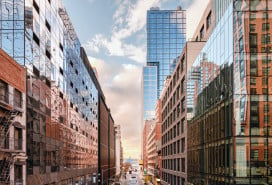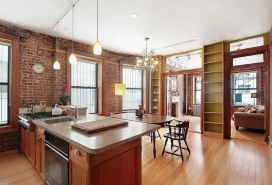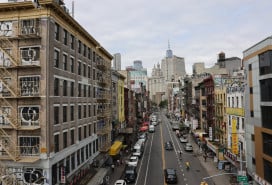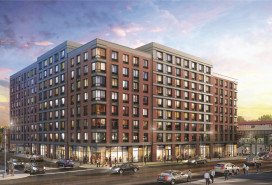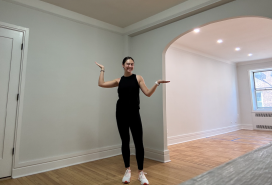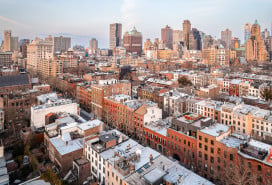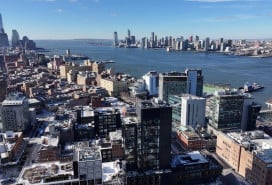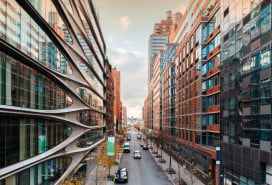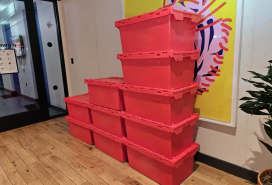Inside Story: My eternity in scaffolding
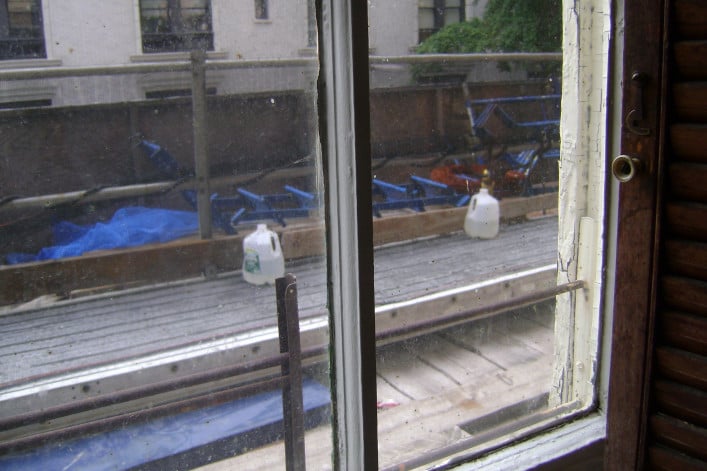
We live on the second floor of a gracious pre-war rental building that occupies a corner on the Upper West Side. In June of 2006, after a small chunk of something fell from on high to the sidewalk (causing no injury, as far as I know), a scaffold and high wood fence immediately went up on one side of the building at the second floor, where all such structures seem to go.
Whether it went up to protect pedestrians or the landlord from litigation by pedestrians, tenants were told only that the situation would be fixed and "pointing" done to the facade.
In came the bricks and shovels, pipes and tarps, buckets and brooms—deposited right outside the windows of our apartment. But of course! This wooden scaffold (aka platform, shed, or bridge) would be the staging area. And what of the workers? What workers? They rarely showed up. And when they did, they were eye-level to our apartment, where I work.
Nearly three years passed. Some of the pointing must have been done, since they scraped at something once in a while, and dust filled the air.
In May 2009, additional planking went up on the avenue side of the building. Since our apartment is on the corner, we were now entirely engirdled—and introduced to a new form of urban claustrophobia.
Away went all of our view, as well as our privacy and our security. With no barbed wire atop the fence (because of “fire laws” I was told), we were vulnerable to any creep who might want to climb aboard our wooden deck—where he’d be perfectly concealed from view—and into our home.
I called 311 and was at last connected to Jennifer Somebody in the Department of Buildings. She encouraged me to file a complaint, after which, she said, an inspector would be sent within 40 days. Great. (I filed the complaint. Did an inspector ever come? Nobody toldme.)
Next, I called the contractor's office—anonymously, from one of the last remaining phone booths in New York—to ask when the job would be done.
“I don’t gotta talk to you,” yelled a thug into the phone, before slamming it down.
This thing has been up for five years. For five years, this filthy platform with its nasty fence has defaced our building and diminished our outlook, in every sense. (We on the second floor are the most obvious victims, but others in the building are demoralized, too.)
Because of the fence that imprisons us, we cannot see the street (do we need an umbrella?) or the sidewalk below (so we may toss a key to our husband, who forgot his). Nor could we anyway, since our windows haven’t been washed in five years because 1) we can’t get out on the platform and 2) what’s the point anyway since dust still fills the air?
On the days they appear, the workers currently seem to be doing something at the rear of the building. But nothing changes for us. No matter where they are, the wooden platform before us continues to serve as repository for their tools and debris.
They don't work in the winter. They don't work in the rain. They don’t work much in any other weather either. They come and they go. They laugh and they curse. They’re having fun. They shout down to a guy in a truck, up to a guy on the roof. They eat their bagels and toss their empty coffee cups to the scaffold floor. And as they strut around out there, mere feet from us at our computers and stoves, they do, yes they do, look in.
According to our brusque young managing agent, to Tina Somebody in our councilwoman’s office, to a lawyer in Mike Bloomberg’s bullpen, to a Corcoran realtor and two real-estate lawyers, it’s legal to renew a platform . . . “until the job is done.”
The job isn’t done. And hasn’t been done in five years. Babies have been born in this time, and neighbors buried. Earthquakes and blizzards have done their jobs and left. But this one goes on and on.
We know that platforms sprout up all over the city--but for weeks or months at a time, not years. Isn’t there a schedule for these things? Shouldn’t there be a deadline? Who’s benefitting? Surely not the tenants—afraid to antagonize the landlord, afraid to withhold the rent, woefully without recourse. Says a reporter friend at the New York Post (whose beat, alas, this is not), “Usually the problem is that the building owner doesn't know what he's doing.”
In January 2010, a community liaison for the Department of Buildings told me that the owners have ”been given a lot of violations.”
What? Doesn’t that matter? A few weeks later, she told me that the Buildings Department has “no authority to make a building finish the job.” Although the workmen returned the very next day—after being absent since the previous November—they didn’t stay long.
This past April, the platform permit was renewed for a sixth year—and accessorized by a vertical scaffold with blue veiling reaching up to the first of the decorative balconies to which the craftsmen with their eyebrow tweezers may or may not one day apply themselves. To this day, no one has climbed it.
While the city recently battened down as Hurricane Irene threatened to throttle us, it occurred to me that our outdoor dilemma should be addressed. Shouldn’t the stuff be removed or tied down? One would think so, considering wind-tossed shovels vs. glass windows. I called management the day before the storm to ask about this, but they don’t work on Saturdays. As it turned out, Irene was a washout, and we were lucky.
As for the health issue: Not only is our indoor greenery continually dying from the possibly toxic dust (we have replaced our indoor trees several times, and they're expensive), but our pet hamster recently died of a cancer the vet had never seen before.
If so, how is the dust affecting the rest of us? (We and the other tenants, I mean. The workers themselves wear masks.) And what about the long, open trough that filled with rainwater a few months ago, thereby becoming a splendid breeding facility for mosquitos just outside our bedroom windows?
It took five different players—from super to handyman to landlord to scaffold guys—to get that thing turned over and emptied. But only because I made mention of West Nile virus and malaria.
We don’t want to move. We’ve never considered it. We love our spacious, beamed-and-molded Classic 6 with its sixteen windows, in which we’ve lived for 30 years and raised two children, and for which we still pay a rent-stabilized rent. How could we ever leave?
Meanwhile our building’s front door is papered top to bottom with permits past and present. As we cross our fingers and bide our time, “the job” plays on. With no end in sight. Or on site either.
More 'Inside Stories':
When your landlord is like family, the rent is low and your boyfriends tiptoe
Inside a broker's mind after 100 days without a closing

